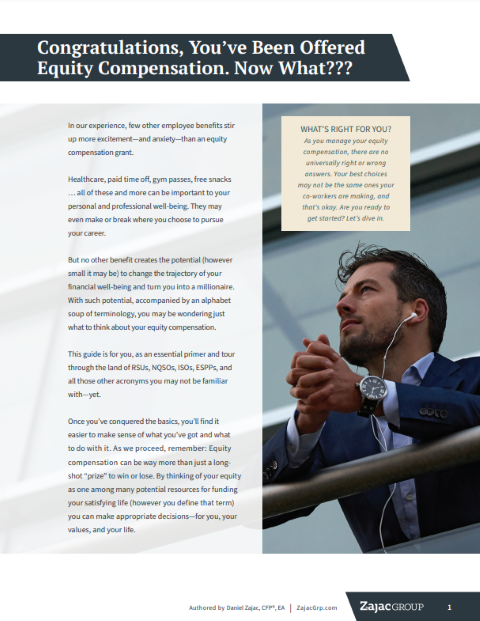Equity compensation and employee stock benefits can be a great tool for employers to attract and retain key talent. These benefits can be equally attractive for employees, because they fast-track your ability to grow wealth if the company’s stock price rises when you can hold and sell shares.
But that’s a big “if.” Stock prices can move in the other direction too, and drop — leaving you with less than you hoped for. A changing stock price, up or down, can have a material impact on the value of your equity compensation.
To understand how a changing stock price may impact your equity, it’s important to look at how the value of various forms of equity compensation are impacted by said change.
How Stock Price Volatility May Impact Restricted Stock Units or Awards
Restricted stock units and restricted stock awards (which we’ll refer to collectively as “restricted stock units” or RSUs for the remainder of this article) most always have some value, so long as the company’s stock price is above $0.
The value of pre-vested units is often easy to calculate, too, leaving less uncertainty around what your equity may be worth. Assuming the restricted stock is issued at $0, the pre-vested value is equal to:
“Restricted Stock Units” x Fair Market Value of the Stock = Current Value
GET THIS GUIDE
When it comes to your finances, it's important to understand what you have, what you should consider, and how it can impact your personal goals. This guide is the best place to start.
Let’s assume you have 1,000 RSUs of a stock with a current FMV of $50 per share. In this example, the total value of your RSUs is:
1,000 x $50 = $50,000
That being said, you can reasonably assume today’s FMV of the stock price will change in the future; it may be higher or lower than the current stock price. If the price is higher, then your RSUs will be worth more. If the price is lower, the RSUs will be worth less.
To illustrate, let’s assume a higher stock price of $100 per share and a lower stock price of $25 per share. Here’s how the value of your RSUs would change, depending on which way the price goes in the future:
Higher Stock Price: 1,000 x $100 = $100,000
Lower Stock Price: 1,000 x $25 = $25,000
The value of your RSUs will increase or decrease at the same rate as the stock price itself.
Employee Stock Options and Stock Appreciation Rights
Things may not be so straightforward if you have stock options or appreciation rights. A key difference between the straightforward RSU and stock options is the exercise price, or strike price.
The exercise price on a stock option is the cost you pay to buy shares when you exercise that option. For your stock option to have value, the FMV of the stock needs to be higher than the exercise price of the option.
We can look at more examples to see how this works. Let’s assume you have 1,000 employee stock options. The fair market value of the stock price is $50 per share and the exercise price is $30 per share.
To calculate the current value of your option, you need the following equation, which we can fill in with the details from our example:
Number of Options x (“FMV” – “Exercise price”) = Current Value
1,000 x ($50 – $30) = $20,000
In this hypothetical, the current value of the employee stock option is $20,000.
Now, let’s look at how employee stock options are impacted by the volatility of the stock price. We’ll look at a higher share price of $100 first, and then see how things change if the share price dropped to $25.
If the stock price rose, the value of your options would increase, too:
Higher Stock Price: 1,000 x ($100 – $30) = $70,000
The fact that the value of your options increases as the stock price goes up isn’t surprising. But what is interesting is that as the stock price increases from $50 to $100 per share, the value of the employee stock option increases from $20,000 to $70,000.
The stock price increased by 100%, but the value of your options increased by 250%.
With your employee stock options, a volatile stock price may result in a wider range of outcomes, due to the inherent leverage associated with the option itself. If this stock price goes up, this can be a good thing if you have options to exercise. If the stock price goes down, however, that same leverage starts working against you in a significant way.
We can see that when we look at what happens if the stock price dropped:
Lower Stock Price: 1,000 x ($25 – $30) = -$5,000
In this example, the FMV of the stock price is below the exercise price of the employee stock option. Your options aren’t just worth less; they’re actually underwater. At this time, the stock option has no intrinsic value and would likely not be worth exercising.
How Volatility in Your Company Stock Price Impacts Your Stock Benefits
If you have stock plan benefits, you should understand how those benefits may be impacted positively and negatively by a moving stock price. Restricted stock units generally provide more certainty that you will end up with at least something should you meet the vesting requirements, regardless of what the company’s shares do on the open market.
Employee stock options, however, do not afford you the same confidence. If you have options, then the company’s stock price needs to remain above the exercise price for there to be a value that you can access.
Arming yourself with all of this detail can help you develop a strategy to better manage your stock benefits to best meet your specific financial goals and objectives.











0 Comments